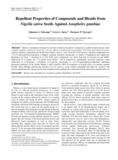| dc.description.abstract | Malaria, transmitted to humans by the bites of infected Anopheles mosquitoes is a public health concern. Some available repellents against the insect have adverse effects on humans and environment. This study determined Anopheles gambiae repellent compounds and blends from Nigella sativa L. seed. From GC-EAD analysis, repellent compounds were 1,2,3,4,5-pentamethylcyclopentane, α-thujene, α-pinene, β-pinene, tetradecane, p-cymene, α-longipinene and longifolene. Repellency of blend 1 consisting of six GC-EAD active compounds was lower than that of essential oil and DEET. Subtraction of p-cymene and (-)-α-pinene from blends 2 and 6 respectively significantly increased repellency while subtraction of (+)-β-pinene, (-)-β-pinene, (+)-α-pinene, tetradecane or 1,2,3,4,5-pentamethylcyclopentane significant decreased repellency of the blends. Blends 2 and 6 repelled 100% of mosquitos at 0.1g/ml while (+)-α-pinene repelled 99.38%. These findings confirm that essential oil of N. sativa L. seeds contain compounds that repel An. gambiae. The positive enantiomer of α-pinene was the most repellent which confirms the compound to be the main active ingredient the oil. | en_US |

